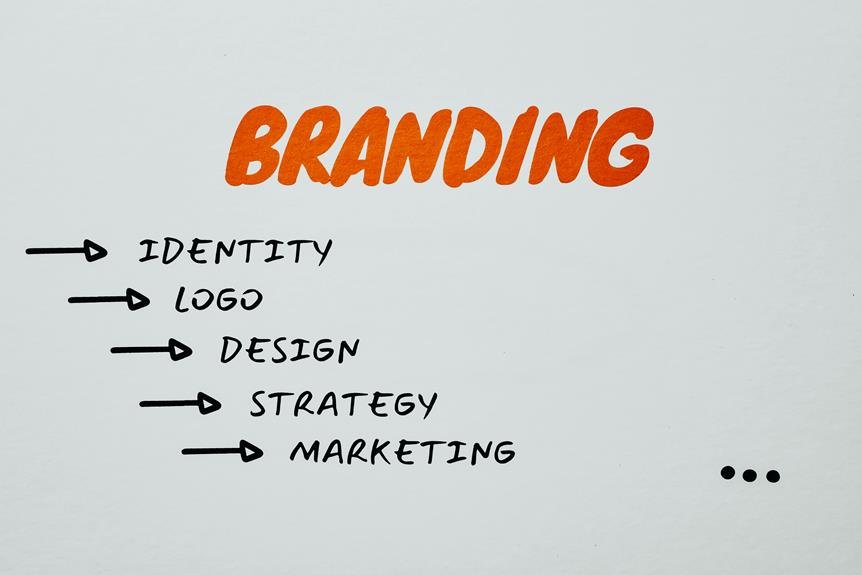To optimize your brand's visual identity for better recognition, start by understanding your target audience and defining your brand personality. Choose a distinct color palette that resonates emotionally and stands out from competitors, while ensuring accessibility. Select typography that reflects your brand's essence and remains readable across platforms. Create a memorable logo that conveys your core message and maintains its integrity in various applications. Use high-quality imagery to enhance professionalism and consistency. Finally, incorporate visual storytelling to connect deeply with your audience. Keeping your identity fresh and relevant is essential, and you'll find more ways to achieve this as you explore further.
Understand Your Target Audience
Understanding your target audience is fundamental for creating an effective visual identity. By conducting a demographic analysis, you can gather essential data about who your audience is. This helps in audience segmentation, allowing you to tailor your brand's visuals to different groups. Furthermore, recognizing cultural relevance guarantees that your designs resonate with diverse backgrounds and experiences.
Behavioral insights play a significant role, as they reveal how your audience interacts with your brand. You want to forge an emotional connection, making your visuals memorable and impactful. Keep an eye on market trends to stay relevant and appealing; this adaptability can set you apart from competitors.
Creating user personas can also guide your design choices, offering a clear picture of your ideal customers. Implementing feedback loops allows you to gather input and refine your visual identity based on real responses. Finally, understanding visual preferences can enhance engagement strategies, guaranteeing your audience feels connected to your brand. By mastering these elements, you'll not only capture attention but also build lasting relationships that drive brand loyalty.
Define Your Brand Personality
To truly connect with your audience, you first need to identify your brand's core values. These values will guide your choices in visual elements, from colors to fonts, shaping how your brand is perceived. By defining your brand personality, you create a consistent and engaging identity that resonates with your customers.
Identify Core Values
Your brand's core values serve as the foundation for its personality, shaping how customers perceive and connect with you. To establish a strong identity, start by defining your brand mission and core beliefs. These elements guide your value proposition and can be articulated in a compelling mission statement, showcasing what you stand for.
Consider your brand ethics; they play an essential role in fostering trust and loyalty among customers. Aligning your values with cultural relevance guarantees that your message resonates with your target audience. This connection can create an emotional bond, making your customers feel that they are part of something bigger.
Incorporating storytelling elements into your branding can effectively communicate your aspirational goals. Share narratives that illustrate how your core values drive your decisions and actions. This not only enhances customer perception but also invites them to engage more deeply with your brand.
Ultimately, your core values are fundamental for optimizing your brand's visual identity. They provide clarity and direction, making it easier for customers to relate to you and, in turn, build lasting relationships that benefit both parties.
Choose Visual Elements
Choosing visual elements is essential for defining your brand personality and making a memorable impression. The right combination of graphic elements can evoke emotional resonance and showcase your brand's unique identity. To stand out, contemplate incorporating iconic imagery that aligns with current design trends and reflects cultural relevance. You should also aim for a minimalist approach to guarantee clarity and focus.
Here are some key aspects to ponder when selecting your brand's visual elements:
- Visual Hierarchy: Organize graphic elements to guide your audience's attention effectively.
- Brand Symbolism: Choose symbols that resonate with your core values and mission.
- Dynamic Visuals: Use engaging and adaptive designs that can evolve with your audience's preferences.
- Emotional Resonance: Confirm your visuals evoke feelings that connect with your target market.
Choose a Distinct Color Palette
How can a distinct color palette elevate your brand's visual identity? A well-chosen color palette not only enhances brand differentiation but also taps into color psychology, influencing customer emotions and perceptions. By considering cultural implications and seasonal trends, you can create a palette that resonates with your target audience while aligning with industry standards.
To illustrate the importance of color in branding, here's a simple table showcasing the emotional impact of various colors:
| Color | Emotional Impact | Color Symbolism |
|---|---|---|
| Red | Passion, excitement | Love, energy |
| Blue | Trust, calmness | Stability, loyalty |
| Green | Growth, health | Nature, renewal |
| Yellow | Happiness, optimism | Warmth, creativity |
| Purple | Luxury, wisdom | Royalty, ambition |
When choosing your color palette, conduct a competitor analysis to identify gaps and opportunities. Verify color accessibility to reach all customers, and aim for visual harmony to create memorable brand experiences. Remember, a distinct color palette can greatly enhance your brand's recognition and connection with your audience.
Select Appropriate Typography
Selecting appropriate typography can greatly impact the effectiveness of your brand's visual identity. The right typeface can convey your brand messaging and evoke the emotional impact you want to achieve. Start by considering typography hierarchy to guide your audience's attention effectively. Combine different fonts through font pairing to create a cohesive look, guaranteeing they complement each other rather than clash.
Here are some key elements to keep in mind:
- Readability Factors: Confirm your text is easy to read, even at smaller sizes.
- Cultural Significance: Be aware of how different typefaces are perceived in various cultures.
- Digital Compatibility: Choose fonts that work well across different digital platforms.
- Typeface Selection: Opt for styles that reflect your brand personality, whether it's modern or traditional.
Create a Memorable Logo
A memorable logo serves as the cornerstone of your brand's visual identity, instantly capturing attention and conveying your core message. When diving into logo design, think about logo symbolism and how it reflects your brand's values. Choose elements that not only resonate with your target audience but also guarantee logo uniqueness, helping your brand stand out in a crowded market.
Keep in mind the importance of logo simplicity. A clean, uncomplicated design often leads to better logo memorability, making it easier for customers to recognize your brand. Additionally, consider logo scalability and versatility; your logo should look great on everything from business cards to billboards.
Stay aware of current logo trends, but don't feel pressured to follow them blindly. Instead, draw logo inspiration from successful brands while making sure your design aligns with your brand's identity. This alignment will strengthen your brand message and create a lasting impression. Ultimately, a well-crafted logo not only enhances recognition but also builds trust with your audience, paving the way for lasting relationships. Remember, your logo is often the first thing customers will see, so make it count!
Consistency Across Platforms
To truly stand out, you need consistency across all platforms where your brand appears. This means using a unified color palette, ensuring your logo adapts well to different formats, and sticking to the same fonts. When your visuals are cohesive, it strengthens your brand identity and makes you more recognizable to your audience.
Unified Color Palette
Creating a unified color palette helps tie your brand's identity together across various platforms. By carefully selecting colors, you enhance brand recognition and create a cohesive visual perception. Colors evoke emotions and carry cultural significance, so it's crucial to understand color psychology and how it influences your audience. A well-thought-out color palette can also help you respond to seasonal trends while maintaining color harmony.
Here are some key aspects to contemplate when developing your palette:
- Emotional Impact: Different colors can trigger specific feelings, so choose shades that resonate with your brand message.
- Color Associations: Research how colors are perceived in different cultures to avoid missteps that could alienate your audience.
- Competitive Analysis: Observe your competitors' color branding to find a unique position that makes your brand stand out.
- Consistency Across Platforms: Verify your color choices are consistent across all marketing materials, from your website to social media.
Logo Adaptability
Your logo serves as the cornerstone of your brand's visual identity, and it must adapt seamlessly across various platforms. To achieve this, focus on logo scalability and versatility. Your logo should maintain its integrity whether it's displayed on a business card, website, or billboard. Different logo applications require variations to guarantee it looks great in all scenarios.
Consider logo responsiveness, which means your design should be flexible enough to fit various screen sizes and orientations. You might need distinct logo colorways for different backgrounds, making sure it stands out without losing brand recognition. Logo integration is vital as it should fit harmoniously with other visual elements in your marketing materials.
Pay attention to logo placement and alignment; these factors can affect how your logo is perceived. Consistent logo usage across all platforms reinforces your brand identity, making it recognizable to your audience. Finally, test your logo in diverse contexts to see how well it performs. By prioritizing logo adaptability, you'll create a cohesive brand experience that resonates with your audience, no matter where they encounter your brand.
Font Consistency
Font consistency is essential for establishing a recognizable brand identity across platforms. When you maintain a uniform typeface, you strengthen your brand voice and guarantee that your audience recognizes your content at a glance. This consistency involves more than just picking a font; it includes careful font pairings that reflect your brand's emotional impact and accessibility standards.
Consider these key aspects:
- Legibility factors: Guarantee your fonts are easy to read across different devices and sizes.
- Typeface hierarchy: Use different weights and styles to guide viewers through your content effectively.
- Cultural considerations: Be mindful of how certain fonts are perceived in different cultures to avoid miscommunication.
- Font licensing: Always check that you have the proper licenses for any fonts you choose to use, especially for commercial purposes.
Use High-Quality Imagery
High-quality imagery can make all the difference in how your brand is perceived. When you use images with excellent image quality, you boost your brand's visual impact and credibility. Whether you opt for brand photography, professional graphics, or original artwork, guarantee that every image aligns with your brand's identity. Stock images can be convenient, but they often lack the unique touch that makes your brand stand out.
Creating an effective imagery strategy involves careful image sourcing and selecting visuals that reflect your brand's mission and values. Consistency is key—aim for visual consistency across all platforms to reinforce brand recognition. For instance, if you choose a specific color palette or style, stick to it in all your visuals.
Don't underestimate the importance of photo editing, either. Well-edited images can enhance your brand's professionalism and appeal. Invest time in refining your visuals to guarantee they resonate with your audience. By prioritizing high-quality imagery, you'll not only captivate potential customers but also establish a strong visual identity that lasts. Remember, your images are often the first impression people have of your brand, so make them count!
Incorporate Visual Storytelling
Incorporating visual storytelling into your brand's strategy can transform how your audience connects with your message. By weaving a compelling visual narrative, you create an emotional appeal that resonates with your target market. This approach humanizes your brand story, making it more relatable and engaging.
To effectively incorporate visual storytelling, consider these elements:
- Imagery Selection: Choose images that reflect your brand values and mission.
- Storytelling Techniques: Utilize techniques such as character development or conflict resolution to deepen the narrative.
- Visual Metaphors: Use metaphors to simplify complex concepts, making them more accessible to your audience.
- Narrative Consistency: Ascertain that all visual elements align with your overall brand message for a cohesive experience.
Test and Gather Feedback
To truly refine your brand's visual identity, you need to test your designs and gather feedback from your audience. Utilizing surveys effectively can help you pinpoint what resonates with people, while conducting focus groups allows for deeper insights into their reactions. By actively engaging with your audience, you can make informed adjustments that strengthen your brand's appeal.
Utilize Surveys Effectively
Surveys can be a powerful tool for refining your brand's visual identity, and using them effectively means tapping into your audience's insights. By selecting the right survey types and designing questions that encourage thoughtful responses, you can gather valuable qualitative insights. Pay close attention to respondent demographics to guarantee you're reaching the right audience.
To make the most of your surveys, consider these tips:
- Utilize survey tools that streamline the process and enhance data interpretation.
- Offer survey incentives to boost response rates and gather more feedback.
- Conduct effective sampling to guarantee your results represent a broader audience.
- Analyze feedback thoroughly to identify patterns and areas for improvement.
Conduct Focus Groups
Focus groups can be an invaluable resource for testing your brand's visual identity and gathering direct feedback from your target audience. By engaging with real people, you'll gain insights into brand perception, design preferences, and emotional connections that resonate with your market. This interaction helps you understand how cultural influences shape audience engagement and strengthens brand associations.
During these sessions, you can implement feedback mechanisms that allow participants to express their thoughts openly. Use usability testing to evaluate how well your designs perform in real-world scenarios. This feedback will also help you conduct a competitive analysis, comparing your visual identity against current visual trends in your industry.
Here's a simple table to illustrate key focus group aspects:
| Focus Group Aspect | Importance |
|---|---|
| Brand Perception | Shapes audience's view of your brand |
| Emotional Connections | Encourages loyalty and engagement |
| Design Preferences | Informs future design decisions |
Monitor and Evolve Your Identity
Monitoring and evolving your brand's visual identity is essential for staying relevant in a fast-changing market. Regularly conducting a brand audit helps you identify areas needing improvement. Keep an eye on visual trends and competitor analysis to guarantee your design aligns with current expectations. An identity refresh can revitalize your brand, enhancing audience perception and maintaining visual coherence.
Consider these key steps to monitor and evolve your identity:
- Perform regular brand audits: Assess your current visual elements and how they resonate with your audience.
- Stay updated on visual trends: Understanding emerging styles can keep your brand fresh and appealing.
- Conduct competitor analysis: Analyze how your competitors present their visual identities and identify opportunities for differentiation.
- Embrace design evolution: Be open to tweaking your visuals to maintain brand alignment with your mission and values.
Conclusion
In summary, optimizing your brand's visual identity is essential for standing out in today's crowded marketplace. Remember, consistent branding can increase revenue by up to 23%. By understanding your audience, defining your personality, and using the right colors and typography, you'll create a memorable presence. Continuously test and evolve your identity to stay relevant. With these strategies, you'll strengthen recognition and foster loyalty, ultimately leading to greater success for your brand.





Leave a Reply